贪吃的小老鼠又回来了,这次有什么新的办法吃到奶酪呢?
规则不变,只能上下左右在格子内移动。
因为上次的深度优先算法让老鼠走了不少冤枉路,这次老鼠带来了帮手探路鼠。探路鼠的使用规则如下:
小老鼠按右、下、左、上的顺序向身边四个格子尝试放出探路鼠,如果遇到猫、出边界、已经有探路鼠存在的格子则放弃。
每只探路鼠都有唯一的顺序号,第一只从1开始,每放成功一只序号递增1。
老鼠探路完成后,找出当前未行动过的顺序号最小的探路鼠重复老鼠的工作,即尝试向右、下、左、上四个格子放出探路鼠。
用图来解释一下,第一步,小老鼠放出两只探路鼠,如下:
老鼠行动完成,按规则是1号探路鼠行动。由于地形所限,1号尝试了右、下、左、上四个方向后,只成功放出了3号。
1号完成后,轮到2号行动,也只成功放出一只,即4号
据此规则不难推算出,接下来依次是:
3号放出5号
4号放出6号
5号放出7号
6号放出8号
7号放出9、10号
8号放出11号
9号放出12号
如下图:
注意12号探路鼠首先发现了奶酪,这时它向上一级即9号汇报,9号向7号汇报。。。,12->9->7->5->3->1->老鼠,可以计算出最少的步数是6。
上面的探路过程即广度优先搜索(Breadth First Search, BFS),与深度优先搜索的一条路走到黑不同,每到一个新的位置都向四个方向分别探索,找出每一个分支,并对每一个分支继续探索。
用程序来描绘这一过程,首先需要把迷宫“数字化“,如下图:
这样就可以用一个二维数组存储迷宫:
int width = 5; //迷宫宽度
int height = 4; //迷宫高度
int[][] maze = new int[width][height];
maze[2][0] = 1;
maze[1][2] = 1;
maze[2][2] = 1;
maze[4][1] = 1;int[][] mark = new int[width][height];
mark[0][0] = 1; static class Trace {
public Trace(int x, int y, int father, int step) {
this.x = x;
this.y = y;
this.father = father;
this.step = step;
}
private int x;
private int y;
private int father;
private int step;
public int getX() {
return x;
}
public void setX(int x) {
this.x = x;
}
public int getY() {
return y;
}
public void setY(int y) {
this.y = y;
}
public int getFather() {
return father;
}
public void setFather(int father) {
this.father = father;
}
public int getStep() {
return step;
}
public void setStep(int step) {
this.step = step;
}
@Override
public String toString() {
return ToStringBuilder.reflectionToString(this, ToStringStyle.JSON_STYLE);
}
}import org.apache.commons.lang3.builder.ToStringBuilder;
import org.apache.commons.lang3.builder.ToStringStyle;
import java.util.ArrayList;
import java.util.List;
/**
* 老鼠走迷宫 BFS算法
* Created by autfish on 2016/9/5.
*/
public class BfsRatMaze {
int min = Integer.MAX_VALUE;
int endX = 4; //目标点横坐标
int endY = 2; //目标点纵坐标
int width = 5; //迷宫宽度
int height = 4; //迷宫高度
int[][] maze;
int[][] mark;
static class Trace {
public Trace(int x, int y, int father, int step) {
this.x = x;
this.y = y;
this.father = father;
this.step = step;
}
private int x;
private int y;
private int father;
private int step;
public int getX() {
return x;
}
public void setX(int x) {
this.x = x;
}
public int getY() {
return y;
}
public void setY(int y) {
this.y = y;
}
public int getFather() {
return father;
}
public void setFather(int father) {
this.father = father;
}
public int getStep() {
return step;
}
public void setStep(int step) {
this.step = step;
}
@Override
public String toString() {
return ToStringBuilder.reflectionToString(this, ToStringStyle.JSON_STYLE);
}
}
public void bfs() {
int[][] next = new int[][] { //按右->下->左->上的顺序尝试
{1, 0},
{0, 1},
{-1, 0},
{0, -1}
};
int head = 0, tail = 1;
int startX = 0, startY = 0;
int nextX, nextY;
List<Trace> traces = new ArrayList<>();
traces.add(head, new Trace(startX, startY, -1, 0));
mark[startX][startY] = 1;
int flag = 0;
while(head < tail) {
for(int k = 0; k <= 3; k++) {
nextX = traces.get(head).getX() + next[k][0];
nextY = traces.get(head).getY() + next[k][1];
if(nextX < 0 || nextX >= width || nextY < 0 || nextY >= height) { //超出边界
continue;
}
//没有障碍且没有探索过, 则把当前位置标记为未探索点
if(maze[nextX][nextY] == 0 && mark[nextX][nextY] == 0) {
this.mark[nextX][nextY] = 1;
traces.add(tail, new Trace(nextX, nextY, head, traces.get(head).getStep() + 1));
tail++;
}
if(nextX == endX && nextY == endY) {
flag = 1;
break;
}
}
if(flag == 1)
break;
//一个点的四个方向探索完成, 取编号最小的一个未探索点
head++;
}
Trace end = traces.get(tail - 1);
int father = end.getFather();
System.out.println("共" + end.getStep() + "步");
StringBuilder path = new StringBuilder();
path.insert(0, "->[" + end.getX() + "," + end.getY() + "]");
while(father >= 0) {
Trace prev = traces.get(father);
father = prev.getFather();
if(father > -1)
path.insert(0, "->[" + prev.getX() + "," + prev.getY() + "]");
else
path.insert(0, "[" + prev.getX() + "," + prev.getY() + "]");
}
System.out.println(path.toString());
}
public void initMaze() {
this.maze = new int[width][height];
this.mark = new int[width][height];
this.maze[2][0] = 1;
this.maze[1][2] = 1;
this.maze[2][2] = 1;
this.maze[4][1] = 1;
this.mark[0][0] = 1;
//打印迷宫 _表示可通行 *表示障碍 !表示目标
for(int y = 0; y < height; y++) {
for(int x = 0; x < width; x++) {
if(x == endX && y == endY) {
System.out.print("! ");
} else if(this.maze[x][y] == 1) {
System.out.print("* ");
} else {
System.out.print("_ ");
}
}
System.out.println();
}
System.out.println();
}
public static void main(String[] args) {
BfsRatMaze b = new BfsRatMaze();
b.initMaze();
b.bfs();
}
}_ _ * _ _
_ _ _ _ *
_ * * _ !
_ _ _ _ _
共6步
[0,0]->[1,0]->[1,1]->[2,1]->[3,1]->[3,2]->[4,2]用深度优先搜索的程序见:










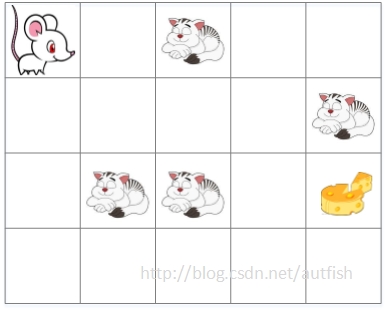
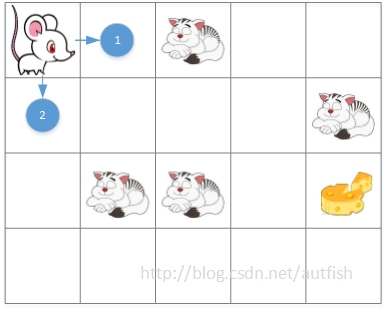
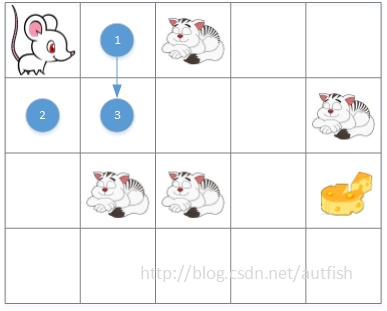
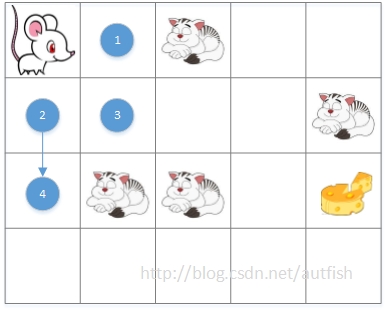
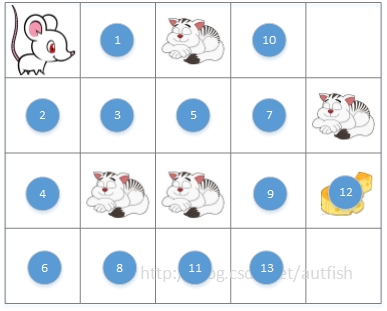
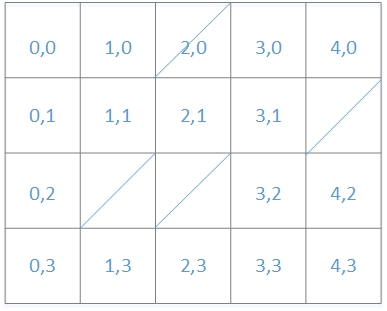














 5909
5909

 被折叠的 条评论
为什么被折叠?
被折叠的 条评论
为什么被折叠?








